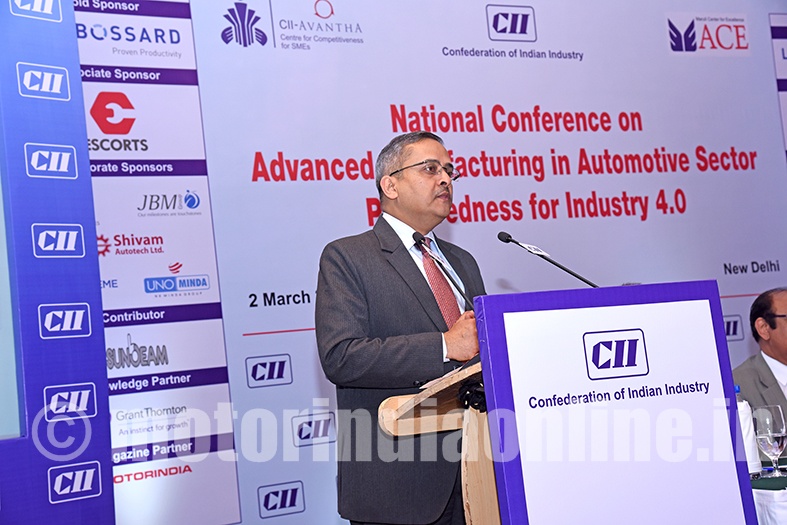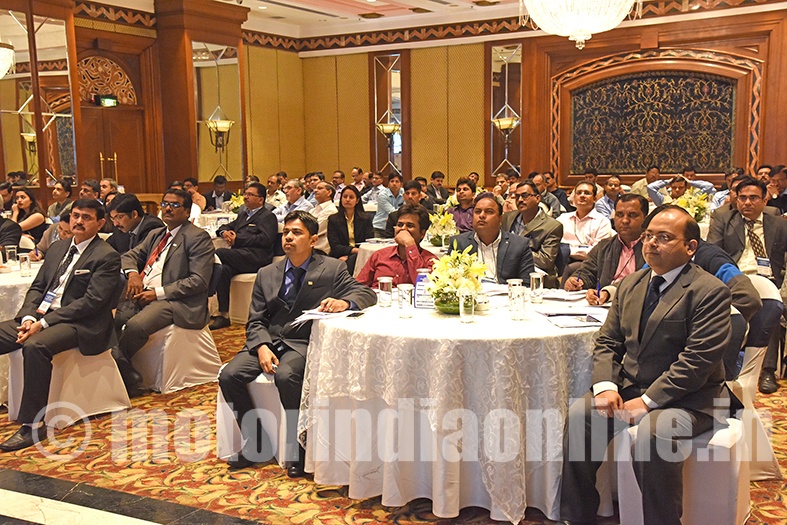The automotive industry is anticipating an all-encompassing paradigmatic shift in its production models, thanks to emerging global manufacturing trends like Industry 4.0 (I4.0) and a plethora of disruptive technologies like Internet of Things (IoT) across the entire automotive value chain. A comprehensive re-imagination of manufacturing and business models is sought among major stakeholders including OEMs and component makers – which was the underlying theme of the ‘National Conference on Advanced Manufacturing in Automotive Sector – Preparedness for Industry 4.0’ organised by Confederation of Indian Industry (CII) on March 2 at New Delhi.

“Disruptive technologies always transform societies”, said Mr. Vineet Talwar, Country Manager, LPS Bossard Pvt. Ltd., while addressing on the enhanced opportunities for firms to make their production systems agile and efficient by adopting the ideals of I4.0. The conference explored how advanced manufacturing techniques and technologies can enhance productivity and reliability, by drawing on experiences from those companies who have adopted smart manufacturing models.
Industry 4.0 envisages ‘smart manufacturing’ with advanced levels of automation, driven by digital and connected technologies across the entire value chain, including shop floors. “A ‘smart factory’ involves connected assets that interlinks ‘3Ps’ – People, Processes, and Products”, said Ms. Sudakshina Ghosh, Director for Automotive and Discrete Manufacturing, SAP India. While Industry 3.0 was merely automation of isolated machines, I4.0 will bring in end-to-end digitisation of all physical assets, creating cyber-physical systems that are integrated into digital ecosystems consisting of IoT, smart sensors, ubiquitous broadband, cloud computing, etc. Augmented reality of using real-time information and big data analytics to facilitate interaction between the ‘3Ps’, and stimulation of systems for assessment and testing on their cost effectiveness resulting in quicker manipulation by firms are some of the corollary benefits of I4.0 ecosystem.
Smart factory logistics and last mile management are the prime areas where manufacturers can gain enormous leverage. Use of sensors-enabled and connected machinery brings seamless integration and transparency in the supply chain. Production processes become leaner and more flexible, resulting in improved predictability, claims LPS Bossard Pvt. Ltd. who demonstrated their connected inventory management system ‘SmartBin Flex’ at the event. Production becomes self-organised, with smooth flow of materials and value addition supported by cloud-based platforms that can handle real time, big data. Moreover, there is an improved scope for intervention at every levels. In a factory setup, interventions can be done at machine level, line level, and at floor level, while functional generative modelling linking OEMs and suppliers upfront can be realised – all without disrupting production and existing orderliness. Technologies like 3D printing and additive manufacturing takes salience in this regard.

Positioning CV manufacturing in the development
The Indian commercial vehicle industry, rated as the eighth largest in the world, foresees a favourable environment for both OEMs and component makers in the near future, thanks to increased demand for road-based logistics, especially in the segments like LCVs and ‘last mile’ mobility. Yet, sales-oriented boost is not that sustainable and can only partly account for overall revenue growth. Companies have to look for new revenue pools, for which a melange of opportunities under I4.0 is on offer. Moreover, the prospects of CV industry is subject to its peculiar externalities, like stringent emission norms and road safety rules are likely in the years to come. Leapfrogging to BS-VI standards by 2019 can be a daunting task, while dominant megatrends like demographic change and consumer preferences, urbanisation, and e-mobility are likely to be disruptive.
For instance, the ‘one size fits all’ approach for CV products seems no longer relevant, as buyers appreciate customised choices that can suit their peculiar needs. The increasing diversification of products lines and option packaging is a testimony to this changing trend. Further, intense competition among alternative products and cost-conscious nature of Indian market limits the leverage enjoyed by companies to a great extent. Therefore, their production systems and business models need to be flexibly responsive to market changes. In this regard, smart manufacturing would come in handy for CV makers and their supply chain, as core processes in assembly are standardized and logistics systems optimised for greater efficiency. Transparent and logistically sound layout wards-off non-value-adding activities in the production chain, hence improved efficiency and predictability.
New avenues of revenue
Further, the world of digitisation and connectivity opens up new avenues of revenue models for OEMs. The new norm of ‘Co-Creation’ prevalent in the passenger car industry where end-users have a very collaborative role in design of individual products and services is the best example. There can also be a ‘service-oriented’ business approach, where the acquisition cost of trucks and buses is spread over their entire life-period, rather than determined once and for all at the point of sale. Connected technologies and vehicle tracking mechanisms can monitor the health of vehicles on a real-time basis and services as per their specific needs at different points of time where OEMs can generate revenues. Vehicle operators and end-users, on the other hand, can benefit from the responsive engagement and transparency in their vehicle’s health and service updates. They can enjoy more choices and custom packaging from OEMs, which together with transparency is likely to improve their satisfaction.
Third opportunity is the innovative engineering solutions of digital manufacturing like Augmented Reality-assisted maintenance, 3D manufacturing, etc. OEMs can reap substantial savings by switching over to these techniques, for instance, vehicle prototyping can be done digitally using 3D that can cut extensive physical crash and other safety tests.
But is the Indian CV industry ready for the big transformation yet? “Automotive firms have to equip themselves for the sweeping changes, else they are left out to perish”, said Mr. Sudhir Bachloo, Industry Sales Manager, Rockwell Automation India Pvt. Ltd. Considerable growth and consolidation of business in the last decade is likely to drive OEMs and component makers towards smart manufacturing, at least for their greenfield projects. Although most of the CV production systems in India are automated, tweaking them to evolve a lean manufacturing must be the first step to begin with. Enablers have to be put in place to displace non-value addition processes in the entire production chain. Another starting point can be collaborative designing that involves seamless integration of OEMs and component makers in churning out engineering models.
Conclusion
Industry 4.0 is revolutionising the way manufacturing is carried out, creating a connected ecosystem where any tiny changes can result in ripple effect all across the entire value chain. So, any transformation in this regard has to include multiple stakeholders, suppliers (both Tier-1 and Tier-2) in particular, not just the OEMs. Considering their numbers and importance, small and medium scale enterprises (MSMEs) are likely to be the flagship drivers towards smart manufacturing and I4.0 in India. “Learning factories as a growth model or consortia can be developed to share best practices and complement the experiences of new industrial revolution”, said Mr. PV Madhusudhan Rao, Coordinator, Innovation Center, IIT Delhi. Capability development is the other area, where “incubation centres for skill upgradation among OEMs and suppliers can help”, observed Mr. MM Singh, Executive Advisor at Maruti Suzuki India Ltd., and the Conference Chairman.
India is the sixth largest automotive manufacturer now, and is poised to emerge as a ‘world-class automotive manufacturing hub’ by next decade. Being a critical driver of economic growth, the automotive industry is at the crossroads for embracing the ‘Fourth Industrial Revolution’, agreed speakers and participants of the conference. The manufacturing landscape is already changing; companies like Bosch are upgrading their production facilities in India to I4.0. There can be no escape from integrating I4.0 with initiatives like “Make in India” either, rendering the industry a conducing environment for a sustainable transformation.
Media Partner: MOTORINDIA
By Dhiyanesh Ravichandran